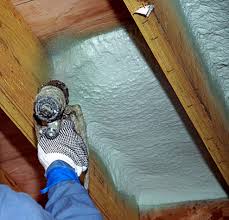
Last time we talked about processing open cell foam and learned in general about the operating range of an SPF product, or the “window of application. This week we are going to dive into some general processing guidelines for closed cell spray foam.
So, first things first, closed cell foam will use the same processing equipment as open cell foam. And if you recall from the discussion about open cell foam, this includes proportioning pumps, like the Graco Reactor 2 E-30 or the PMC PH-25, 200 to 300 foot of heated hose and a compatible spray gun, like the Graco Fusion AP Gun or the PMC AP-2 Spray Gun.
However, there are a few key differences, closed cell resin should not be mixed and, in most cases, the manufacturers recommend keeping closed cell resin drums below 85°F to minimize evaporation of the blowing agent and maintain optimum yield. As the weather gets hotter in the summer months you may see significant pressure build up inside of closed cell resin drums. If this occurs you should try and cool the drum to liquefy the 245fa and reduce drum pressure or consult drum depressurization guidelines for alternative exhaust methods.
Also, like open cell foam, closed cell foam will have a “sweet spot” or “window of application”, where you get good quality foam and minimize shrinkage and void issues, this is your optimum processing range. The processing settings for your equipment are affected by various conditions including ambient temperature & humidity, drum temperature and substrate temperature. You will use equalized pressures on the A and B side, typically between 800 and 1200 psi, and you will generally spray closed cell foam at lower temperature settings than open cell foam, for example between 100 and 125°F. You can refer to your technical data sheets for more information on your specific products and consult with your manufacturer’s technical rep. for initial processing recommendations.
Regardless of whether you are working with open cell foam or closed cell foam, your job is to convert drums of material into sq. ft. of good quality, applied foam, to maximize your yield, minimize your waste and improve your bottom line, and these tips can help.
Stay tuned next week as we discuss troubleshooting.
Subscribe here to get your FREE copy of 25 Spray Foam Insulation Frequently Asked Questions from Spray Foam Advisor.


